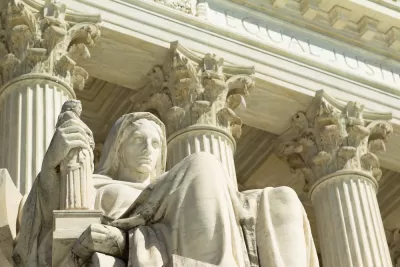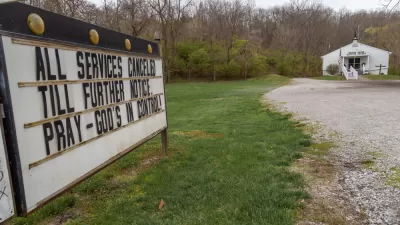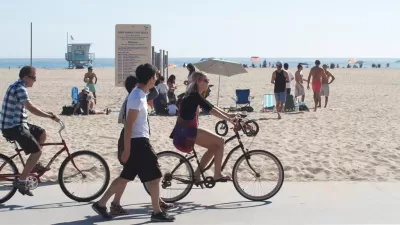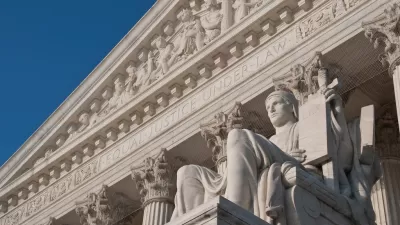In a 5-4 decision, the court voted to uphold the prohibition of religious services that was part of California Gov. Gavin Newsom's stay-at-home order. While the restriction had since been loosened, the plaintiff wanted all restrictions removed.

“California’s latest safety guidelines discriminate against places of worship and in favor of comparable secular businesses,” wrote Justice Brett M. Kavanaugh. “Such discrimination violates the First Amendment.”
Justices Clarence Thomas and Neil M. Gorsuch joined Kavanaugh’s dissent. The court’s order said Justice Samuel A. Alito Jr. also would have granted the church’s request, but he did not join the Kavanaugh statement.
A few days after the Ninth Circuit upheld the church services ban, Newsom issued new, controversial guidance [pdf] that permits indoor church services with one notable restriction.
Places of worship must therefore limit attendance to 25% of building capacity or a maximum of 100 attendees, whichever is lower. This limitation will be in effect for the first 21-days of a county public health department’s approval of religious services and cultural ceremonies activities at places of worship within their jurisdictions.
"Even if just one infected person showed up to such an event, the virus could easily be transmitted to many people and overwhelm local health officials’ ability to investigate all related cases," warned Santa Clara County Health Officer Sara Cody on May 26. Cody worked with five of her counterparts in Bay Area counties to shut down the region just a few days before Newsom did so, which many public health experts credit for their flattening the curve.
Barnes notes that the expert who testified on behalf of California presented evidence of just such infection spread, including "a worship service in Sacramento tied to 71 COVID-19 cases; a choir practice in Seattle [sic]; linked to 32 cases; a Kentucky church revival tied to 28 cases; and a religious service in South Korea where over 5,000 cases were traced back to a single infected individual in attendance.”
Advice to courts
In a follow-up piece published on May 30, Barnes writes that in five paragraphs, "Roberts laid out what will likely be the test for courts going forward."
"Protecting public health is a "dynamic and fact-intensive matter subject to reasonable disagreement, but one the Constitution “principally entrusts” to elected officials.
Generally, he said, “they should not be subject to second-guessing by an unelected federal judiciary, which lacks the background, competence, and expertise to assess public health and is not accountable to the people.”
In his earlier piece, Barnes wrote that Roberts quoted a court precedent in this sentence.
Related in Planetizen:

Study: Maui’s Plan to Convert Vacation Rentals to Long-Term Housing Could Cause Nearly $1 Billion Economic Loss
The plan would reduce visitor accommodation by 25,% resulting in 1,900 jobs lost.

North Texas Transit Leaders Tout Benefits of TOD for Growing Region
At a summit focused on transit-oriented development, policymakers discussed how North Texas’ expanded light rail system can serve as a tool for economic growth.

Why Should We Subsidize Public Transportation?
Many public transit agencies face financial stress due to rising costs, declining fare revenue, and declining subsidies. Transit advocates must provide a strong business case for increasing public transit funding.

Dear Tesla Driver: “It’s not You, It’s Him.”
Amidst a booming bumper sticker industry, one writer offers solace to those asking, “Does this car make me look fascist?”

A Visual Celebration of Manhattan’s Chinatown Elder Community, Through Food
Lanterns, cafeteria trays, and community connection take center stage in this stunning photo essay.

How to Make US Trains Faster
Changes to boarding platforms and a switch to electric trains could improve U.S. passenger rail service without the added cost of high-speed rail.
Urban Design for Planners 1: Software Tools
This six-course series explores essential urban design concepts using open source software and equips planners with the tools they need to participate fully in the urban design process.
Planning for Universal Design
Learn the tools for implementing Universal Design in planning regulations.
City of Santa Clarita
Ascent Environmental
Institute for Housing and Urban Development Studies (IHS)
City of Grandview
Harvard GSD Executive Education
Toledo-Lucas County Plan Commissions
Salt Lake City
NYU Wagner Graduate School of Public Service





























